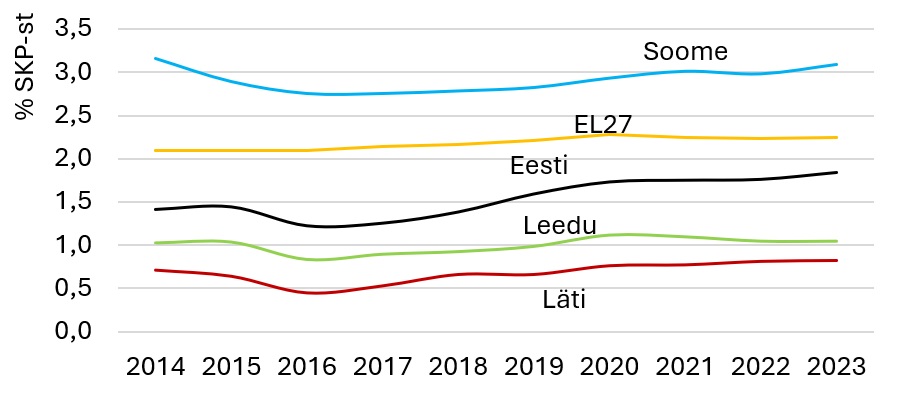Report: The Estonian economy is more knowledge-intensive, but Lithuania makes more money even with simpler businesses
The Lithuanian economy is growing faster than the Estonian economy, and the Lithuanian government has been bolder in stimulating the economy with tax reliefs. According to the Foresight Centre’s new short report “Estonian Economic Competitiveness in Comparison with Latvia, Lithuania and Finland”, knowledge-intensiveness is considered to be Estonia’s strength, while Lithuania is able to generate substantial revenue even with simpler services.

In the last three years, the Lithuanian economy has grown faster than the Estonian economy, and in 2024, Estonia’s nominal growth rate was 2.4 percentage points lower than that of Lithuania.
Uku Varblane, head of research at the Foresight Centre, explained that Estonia has considerable strengths compared to Lithuania, and Lithuania’s success may be temporary if Estonia is able to capitalise on its strengths. “Our businesses invest significantly more in research and development, and close ties with the Nordic countries provide good opportunities for knowledge transfer,” said Varblane. “This is also supported by our well-developed startup ecosystem, which fosters innovation and the development of deep technologies.” He added that potential growth factors need to be utilised better in Estonia.
In its short report, the Foresight Centre points out that the Lithuanian government has been bolder in experimenting with tax policies among other things. For example, in Lithuania, companies can deduct research and development expenses threefold from taxable income, and there are income tax exemptions for large investments. In addition, Lithuania has implemented various “green corridor” measures to speed up procedures.
Urmas Varblane, Chairman of the Supervisory Board of Eesti Pank and member of the Competitiveness Expert Council, stressed that for the new growth cycle of the Estonian economy to begin, a stable economic environment needs to be ensured, including a tax environment, which would foster confidence in entrepreneurs and consumers and restore faith in the future of the Estonian economy. “Entrepreneurs should be provided with as much information as possible of the direction we are heading in as a country,” he said. There are encouraging examples, such as the steps planned in the newly published energy development plan and measures designed to attract large industrial investments. “These steps give us hope that soon, there will be more businesses like the magnet factory in Narva and the Elcogen fuel cell factory near Tallinn.”
One of the reasons for the Lithuanian economy’s faster growth is considered to be its diversity, with the chemical industry, fuels and transport, as well as financial and ICT services as significant contributors. There are also more large companies in Lithuania, allowing for both economies of scale and greater market power. In addition, Lithuanian companies have actively used European Union stimulus funds to purchase equipment, which has provided them with a strong technological base.
Lithuania’s orientation towards Central Europe has also put it in a favourable position in recent years compared to Estonia, which is focused on the Nordic countries who have recently experienced worse performance. Lithuania has made very good use of its locational advantage. For example, Lithuania’s land transport sector stands out for its turnover of 12.6 billion euros last year, employing nearly 150,000 people.
The Foresight Centre notes in its short report that the challenges of the near future are similar in the Baltic countries. Increasing productivity and maintaining competitiveness in the face of rapidly rising labour costs are common challenges for the three Baltic countries. Estonia, however, needs to transform current research and development activities into real economic growth and revenue.
The short report “Estonian Economic Competitiveness in Comparison with Latvia, Lithuania and Finland” (in Estonian) has been prepared within the framework of the research stream “The Future of Economic Competitiveness“. The research stream analyses the future prospects, opportunities and obstacles of the Estonian economy and presents promising economic policy recommendations. The research stream is part of the work of the Competitiveness Expert Council established at the Economic Affairs Committee of the Riigikogu.
Latest news
-
10.11 2025Report: Estonia could learn how to control healthcare costs from the Netherlands
The expenses of the Estonian Health Insurance Fund significantly exceed its revenues, and the accumulated reserves will be depleted in the next five years. Other European countries in the same situation have cut healthcare services and increased people’s co-payments. According to the Foresight Centre’s new short report “Other countries’ experiences in managing healthcare budget deficits”, both solutions have worsened public health and deepened inequality.

 An independent think tank at the Riigikogu
An independent think tank at the Riigikogu